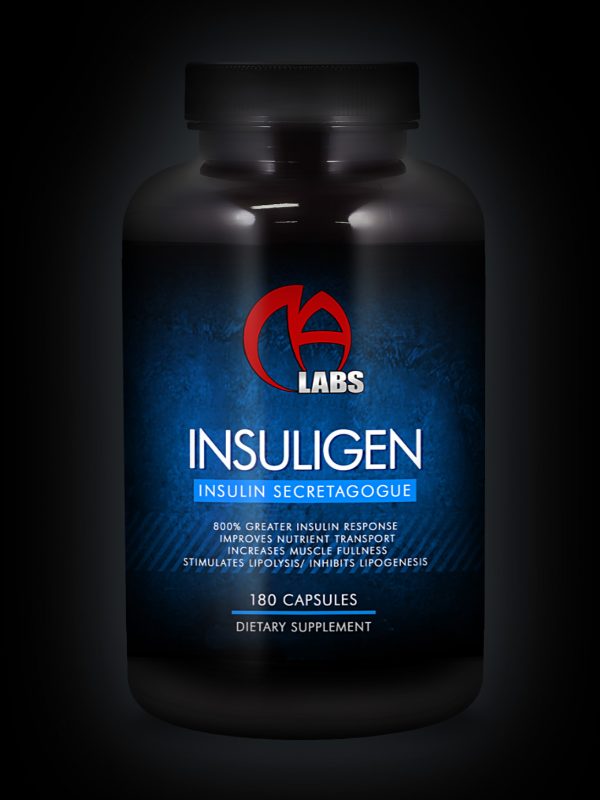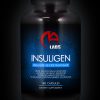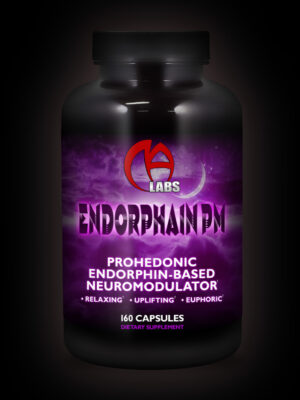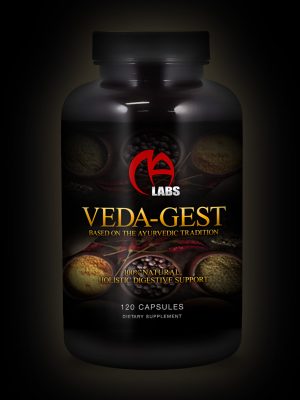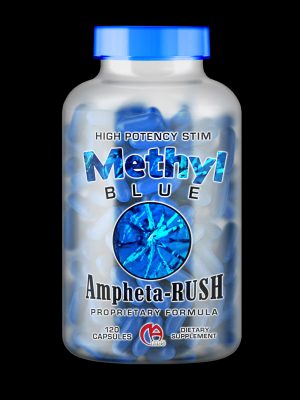Description
Insuligen
“The Industry’s 1st Insulin Secretagogue”
Insuligen at a glance…
- The Industry’s 1st Muscle-Building Glucose Disposal Agent (GDA)
- Increases Insulin Levels 800% More than the Competition
- Stimulates Muscle Tissue Specific Glucose Transport
- Improves Nutrient Absorption
- Doesn’t Suppress Protein Synthesis via Excessive AMPK Activation (like virtually every other GDA on the market today)
- Initiates Fat Loss via Increased Lipolysis
- Prevents Fat Gain via the Inhibition of Lipogenesis
GDA’s: Sensitizers, Mimetics, and Secretagogues
Whether we’re talking about sports nutrition stores, online wholesalers, or direct to consumer companies, one thing they all have in common is that they offer a wide variety of products claiming to provide insulin-like effects. Normally referred to as glucose disposal agents, or GDA’s, these products fall into one of three categories: insulin sensitizers, insulin mimetics, and insulin secretagogues. However, for the average consumer, deciphering between this diverse class of supplementation can be difficult and even confusing. Further complicating matters is that these terms are often used interchangeably, leading one to believe that they are one in the same. While there are certainly similarities between them, there are also important differences, with each one producing its own unique effects in the body. Therefore, before we can effectively differentiate MA Labs’ Insuligen from the other GDA’s on the market, we must first possess a basic understanding of the class as a whole, as well as the underlying mechanisms of action for each category.
Keep in mind that the term GDA is somewhat ambiguous, or generic in nature, as it is an umbrella term used to describe the class as a whole. This is because the name itself refers to a singular function applicable to all categories, rather than a trait unique to a particular category. Therefore, the term “GDA” can be applied to any product claiming to provide insulin-like effects. Now that we know what the different categories of GDA’s are, let’s look at the primary differences between them:
- Insulin Sensitizers: This category of GDA’s increases our cells’ responsiveness (i.e. sensitivity) to insulin, thereby enabling us to use this hormone more efficiently/effectively.
- Insulin Mimetics: This category of GDA’s works by copying (or mimicking) the effects of insulin in one or more ways. For example, one way in which they might mimic insulin is by activating the translocation of Glut-4; a transporter protein utilized in the shuttling of glucose into muscle cells.
- Insulin Secretagogues: This category of GDA’s differs from the previously mentioned categories, in that it actually causes the pancreas to secrete insulin into the bloodstream, resulting in greater overall insulin levels.
Although the descriptions I provided above are accurate, the reality is that none of these categories function solely within their respective category. In other words, while an insulin sensitizer may function primarily as a sensitizer, it may also possess some degree of mimetic and/or secretagogue effects, albeit to a lesser degree. The same goes for both mimetics and secretagogues.
While this can sometimes be a good thing (all categories have benefits), neither sensitizers nor mimetics are a replacement for insulin, as they are limited in terms of both functionality and potency. Unfortunately, they simply aren’t capable of replicating insulin’s full range of physiological effects, particularly in those areas responsible for regulating muscle growth. Anyone who is experienced with both insulin and GDA’s will readily attest to this fact, as GDA’s are known more for their fat loss/recomping effects than for stimulating recovery & growth. There are multiple good reasons for this, but there is one main reason. Enter AMPK.
AMPK & GDA’s
For those of you who are unfamiliar with the term AMPK and what it means to bodybuilders, allow me to give you a brief crash course on this important, yet often misunderstood enzyme. AMPK, otherwise known as adenosine monophosphate-activated protein kinase, is an enzyme involved in regulating energy metabolism. When this enzyme is activated, such as during exercise or starvation (or in this case, when using traditional GDA’s), it can produce a number of beneficial effects, including decreased inflammation, increased fatty acid oxidation (e.g. the burning of fat for fuel) and increased glucose uptake.
Naturally, this would make AMPK activation an enticing target for supplement formulators, so it probably wouldn’t surprise you to learn that today’s GDA’s are comprised almost entirely of these substances. This is an important point to consider, as both insulin sensitizers and mimetics derive the vast majority of their insulin sensitizing effects as a direct result of AMPK activation. In fact, the terms AMPK activator and insulin sensitizer/mimetic have become so closely associated that they are almost synonymous.
Metformin and berberine would be great examples of AMPK activators. Both of these are well known to provide a moderate recomping effect (via fat loss), along with significant improvements in overall metabolic health. With such a large number of potential beneficial effects (from both a cosmetic and health standpoint), it is not unreasonable to assume that more is better…and that’s exactly where most supplement companies have erred.
AMPK Activation and Muscle Growth?
Using a product comprised almost entirely of AMPK activators is a great idea if your primary goals are heath and fat loss oriented, but if muscle growth is at the forefront of your priority list, this is problematic. This is because AMPK activation is antagonistic to mTOR, acting as a negative feedback control to restrain muscle hypertrophy. In other words, AMPK activation directly and strongly inhibits protein synthesis, causing a decrease in muscle growth.
Now, before you start thinking that all AMPK activation is inherently bad for bodybuilders and should therefore be eliminated, think again. The truth is that some degree of AMPK activation is not only essential for our health, but is also necessary for muscle growth. However, excessive activation of this enzyme, especially during times when catabolism is at its peak (i.e. during the training window, for instance), will directly impede your ability to build muscle mass. Therefore, any product which contains copious amounts of sensitizers and/or mimetics should be avoided when muscle growth is the goal, especially at these times.
Unfortunately, nearly every GDA on the market today is loaded to the gills with insulin sensitizers/mimetics. It is no longer uncommon to see GDA’s containing 4, 5, or even more powerful AMPK activators—often at very high dosages—within a single formula. Using a product like this, especially multiple times daily, is the last thing you want to do when trying to grow. You are much better off saving these kinds of products for times when fat loss is the overriding goal, such as during contest prep or simply when trying to get in the best shape possible.
Muscle Building GDA’s vs. Fat-Loss GDA’s.
Insuligen was formulated specifically to AVOID this modern-day pitfall by relying primarily on insulin itself (via insulin secretagogues) to power it’s unique effects, rather than AMPK activation. Unlike other GDA’s, which aren’t really insulin-like at all (how can a product claim to be “insulin-like” when it not only fails to assist with muscle growth, but actually hinders it?), Insuligen will provide the effects that bodybuilders have been seeking from these products all along—glucose transport in combination with improved recovery and growth. As a side benefit, it will even assist with fat loss/prevent fat gain.
Further improving its effect profile is that Insuligen provides just enough AMPK activation to help maintain insulin sensitivity in the face of elevated insulin levels, allowing the user to reap maximum benefit from the large increase in circulating insulin levels without experiencing the negative effects typically associated with a high insulin environment. In other words, you get the best of both worlds—elevated insulin levels when you need it, but without any of the negative side effects typically associated with a hyperinsulinemic state; all while simultaneously assisting the individual in their health and fat loss goals.
While the idea of formulating a product based solely around insulin secretagogues is a relatively simple concept, Insuligen is the first product to actually do so. Up until now, GDAs have been nothing more than a hodgepodge of randomly selected compounds, focusing solely on glucose disposal and insulin sensitivity without any regard for the detrimental effects they may have on the growth process. This all changes now.
Insuligen: Ingredients
GymnePURE®: Insuligen is the first GDA released within the bodybuilding-fitness industry to contain this novel and costly ingredient. In short, GymnePURE® is the safest, most biologically active and effective Gymnema Sylvestre extract ever developed. This is NOT your typical Gymnema product, which is nothing more than ground up leaf occasionally standardized for gymnemic acids. Rather, GymnePURE® is a unique and innovative multi-patented extract of natural Gymnema Sylvestre Leaf using a scientifically supported extraction process known as OSA™.
When looking at GymnePURE® from a biological standpoint, there are two primary characteristics which differentiate it from traditional gymnema products—potency and safety. Research performed at King’s College in London shows us just how powerful GymnePURE is. When compared directly against multiple other gymnema extracts, just a single 250 mg dose of GymnePURE® elevated insulin levels 600%-1,600% higher than a full 8 capsules (1,000-2,000 mg) of standard gymnema extract, with the average increase being 800% greater. No other Gymnema product on the market even comes close, making GymnePURE® the premier insulin secretagogue available today.
But how does GymnePURE® stack up to the competition from a safety standpoint? This rarely talked about aspect of gymnema usage may be more important than you think, particularly in individuals with compromised beta cell viability or in those who regularly use GDA products. Located in the pancreas, beta cells are the cells responsible for secreting insulin into the bloodstream. When these cells are damaged through chronic/excessive insulin secretion (Type II diabetes, for example) or improper supplementation, they can partially or even totally lose their ability to release insulin into the bloodstream.
The safety difference between GymnePURE® and other gymnema extracts lies in its mechanism of action (M.O.A). Regular gymnema extracts possess a less than ideal M.O.A, as they stimulate insulin secretion by literally breaking down the beta cell walls, causing insulin to leak into the bloodstream. This unnatural method of inducing insulin secretion leads to subsequent beta cell wall exhaustion and eventually, death. You may want to think about this the next time you reach for your gymnema containing GDA product.
In contrast, GymnePURE® works by opening and closing the cell walls in a natural manner, thus preserving their integrity and future ability to perform vital functions. But this is not GymnePURE’s only MOA. It also works through signaling pathways in the presence of Ca and even in the absence of Ca. This three-fold mechanism of action is far superior to anything encountered with normal gymnema extracts, both from an effectiveness and safety standpoint. GymnePURE® accomplishes all this without activating AMPK, so you don’t need to wonder if your muscle building efforts are being compromised.
4-Hydroxyisoleucine: 4-Hydroxyisoleucine, otherwise known as 4-HIL, is a non-protein amino acid isolated from Fenugreek seeds. Although 4-HIL has been known about for some time now, it is almost never included in GDA’s at a meaningful dose (the last time I saw a properly dosed 4-HIL product was 12-15 years ago and it was the only ingredient in the product), and when it is listed on the label, it is always part of an undisclosed (i.e. ineffective) proprietary blend. This is due to its excessive cost, as a single 200 mg dose (the dose found in Insuligen) has a higher production cost than most GDA products do in their entirety. Although highly effective, this makes 4-HIL an impractical addition to many multi-faceted GDA products, unless the company is willing to abandon conventional profit margins in the pursuit of effectiveness.
Like GymnePURE®, 4-HIL does not activate AMPK, but directly activates pancreatic islets, causing insulin to be released into the bloodstream. In addition to its insulin secreting effects, 4-HIL also possess the ability to lower plasma glucose through non-insulin dependent pathways, while simultaneously improving HDL levels and lowering total cholesterol and triglycerides.
Beta-umbelliferone: Beta-umbelliferone, also referred to as 7-hydroxycoumarin, is an interesting compound with a plethora of beneficial effects. Never before used in a GDA product, umbelliferone is the parent compound from which the prescription medication, Warfarin, is derived. However, unlike warfarin, umbelliferone does not have any significant blood thinning properties, but instead acts as an insulin secretagogue, anti-oxidant, and anti-inflammatory agent.
Impressively, umbelliferone has been shown to possess insulinotropic effects comparable to the powerful prescription insulin secretagogue, glibenclamide, but without the AMPK activation that is so prevalent among GDA’s in general. That is a very significant finding, as glibenclamide is one of the most effective and long-standing secretagogues used in medicine today. Even better, Umbelliferone does this without any harmful side effects; something that cannot be said of glibenclamide, which has numerous contraindications and potentially serious negative effects on the patient’s health.
As a side benefit, umbelliferone also helps prevent/reverse inflammation induced liver injury, making it a powerful and natural liver protectant. This hepatoprotective effect is largely attributable to umbelliferone’s anti-inflammatory properties, which have been repeatedly demonstrated in clinical studies. Most notably, it has been shown to reduce hepatic TNF-a, IL-1β, and IL-6 levels. These inflammatory cytokines play a critical role in the progression of liver injury by provoking hepatocellular injury and death, while TNF-α and IL-1β act as sensitizing factors, amplifying hepatocyte damage by inciting hepatic leukocyte infiltration.
Ampalaya: More commonly known as Momordica Charantia or bitter pear, Ampalaya is a routinely used oral hypoglycemic agent capable of stimulating glucose uptake through multiple pathways. Acting as an insulin secretagogue, insulin sensitizer, and insulin mimetic, Ampalaya provides a number of benefits not found with secretagogues alone. In addition to its clinical efficacy, Ampalaya was selected for this very reason, as it activates AMPK just enough to provide a potent insulin sensitizing effects, but not so much that it impairs the growth process.
Although there are dozens of hypoglycemic agents found in Ampalaya, the most powerful of these include: charantin, polypeptide-p and to a lesser extent, vicine. Charantin functions as an insulin secretagogue and has been shown in clinical studies to produce a more powerful insulinotropic effect than the prescription secretagogue, tolbutamide. Polypeptide-p functions as a potent insulin mimetic, closely resembling insulin in both structure and effect. So comparable is its physiological effects to insulin that it can even be used as an insulin replacement in Type I diabetics. There are at least a dozen additional hypoglycemic agents found within Ampalaya, all of which contribute to the overall effects of this amazing plant.
Enhanced Bioavailability
When designing an GDA formula, one could decide to include only the most powerful ingredients available, but if they are poorly absorbed due to low bioavailability, it means very little. Therefore, it would behoove any supplement company to make sure that this aspect of product development is not overlooked. In many cases, the simple addition of one or more bioavailability enhancers is all that is required to greatly improve a product’s absorption into the bloodstream, thereby enabling the product to provide the results it was intended to.
For Insuligen, I have chosen to use a combination of 4 different compounds, all of which are backed by a mountain of clinical research. These include BioPerine (a trademarked version of piperine), ginger, cumin seed, and gallic acid. Each of these possesses a different mechanism of action and/or work synergistically with the others to further improve bioavailability. Mechanisms of action include p-glycoprotein inhibition, stimulation of gut amino acid transporters, inhibition of drug metabolizing enzymes, reduced production of intestinal glucuronic acid, and increased bile production and digestive motility.
By optimizing virtually every variable associated with the absorption process, you can rest assured that you are receiving maximum benefit from the compounds within Insuligen.
***IMPORTANT***
Insuligen: Glucose Dependent
When using Insuligen, it is very important to understand that its effects are almost entirely glucose dependent. What does this mean? It means that the substances within Insuligen only stimulate insulin secretion in response to the presence of elevated blood glucose levels…and the greater the elevation, the greater the insulinogenic response. In other words, the more carbs you eat, the better the product works, while those who eat little to no carbs will notice little to no results. Yes, its lipolytic and anti-lipogenic effects will still be present, as will a portion of its insulin sensitizing effects, but without adequate carb intake insulin secretion will be minimal to non-existent. Therefore, low-carb dieters need not apply. Insuligen was designed specifically for those interested in building muscle mass.
Given the fact that Insuligen is glucose-dependent, one should not expect to experience hypoglycemia when using it, regardless of the dose employed, because as soon as Insuligen has done its job (lowered BG levels back down into a normal range), insulin secretion will cease. This self-modulatory effect is exactly what we want out of a secretagogue, as it not only prevents the occurrence of hypoglycemia, but also helps prevent insulin resistance and potential fat gain.
Conclusion
As the 1st product of its kind, Insuligen’s arrival ushers in a new class of GDA’s—the muscle-building GDA. By foregoing AMPK activation as its primary M.O.A., Insuligen takes a step away from the anti-growth approach that typifies most GDA’s and instead chooses to rely on endogenous insulin production to power its effects.
By providing a more muscle-friendly GDA, Insuligen helps fill the gap left by the current roster of GDA products, which are more suited for fat-loss and/or recomping. As always, MA Labs is proud to introduce to you it’s newest release in the MA Labs line-up—Insuligen.

